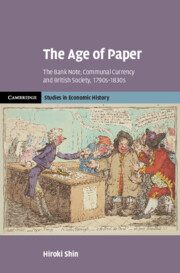
-
Select format
-
- Publisher:
- Cambridge University Press
- Publication date:
- December 2024
- January 2025
- ISBN:
- 9781009503280
- 9781009503273
- Dimensions:
- (228 x 152 mm)
- Weight & Pages:
- 0.62kg, 332 Pages
- Dimensions:
- Weight & Pages:
You may already have access via personal or institutional login
Book description
In the first detailed examination of Britain's transition to paper currency, Hiroki Shin explores how state, nation and community each played their respective role in its introduction. By examining archival materials and personal accounts, Shin's work sheds fresh light on societal, institutional, communal and individual responses to the transformation. The dominance of communal currency during the Bank Restriction period (1797–1821) demonstrates how paper currency derived its value from the community of users rather than the state or the intrinsic value of precious metal. Shin traces the expanded use of the Bank of England note – both geographically and socially – in this period, revealing the economic and social factors that accelerated this shift and the cultural manifestations of the paper-based monetary regime, from everyday politics to bank-note forgeries. This book serves as an essential resource for those interested in understanding the modern monetary system's historical origins.
Reviews
‘Technically assured and intellectually ambitious, Hiroki Shin has given us in The Age of Paper a fascinating account of a unique era in British financial history – an account that, to his book's huge benefit, embraces the broader political, social and cultural dimensions as well as the more narrowly economic.'
David Kynaston - author of ‘Till Time's Last Sand: A History of the Bank of England, 1694–2013'
‘A fascinatingly written account of how the Bank of England note became Britain's most important currency. Erudite and thought-provoking, Shin opens up, and challenges, key debates about the experience and acceptance of paper money. A ‘must read' for all scholars of the long eighteenth century.'
Anne Murphy - author of ‘Virtuous Bankers'
‘The author eloquently communicates and cogently analyses everything there is to learn about this seminal episode in British monetary history and theory.'
Patrick Karl O'Brien - author of ‘The Economies of Imperial China and Western Europe: Debating the Great Divergence'
‘This book offers valuable insights into the transformative forces shaping the history of Britain during the Bank Restriction period and beyond, shedding light on the transition to paper currency and its enduring impact. I highly recommend it.'
Contents
Metrics
Full text views
Full text views help Loading metrics...
Loading metrics...
* Views captured on Cambridge Core between #date#. This data will be updated every 24 hours.
Usage data cannot currently be displayed.
Accessibility standard: Unknown
Why this information is here
This section outlines the accessibility features of this content - including support for screen readers, full keyboard navigation and high-contrast display options. This may not be relevant for you.
Accessibility Information
Accessibility compliance for the PDF of this book is currently unknown and may be updated in the future.

